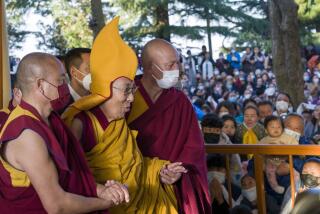Dalai Lama Fears Effects of Clash Over Leadership : Buddhism: On U.S. visit, religious figure says China may try to exploit a prolonged debate over which of two youngsters is a living Buddha.
- Share via
SAN FRANCISCO — Amid rising international attention on human rights violations in China, the Dalai Lama, stopping in the Bay Area this week during a five-city American tour, entered the fray in the controversy over whether there is a living Buddha, and suggested that the Chinese government might try to use the debate to divide the Tibetan people.
The revered Tibetan leader, who makes his home in exile in Dharmasala, India, spent two days in Northern California, including a visit with Stanford University professors and a major address at UC Berkeley.
During a meeting with reporters in Menlo Park, he talked about everything from his penchant for watching the TV show “MASH” before evening prayers to U.S. economic policy toward China, which has occupied Tibet since 1950.
The Dalai Lama has unsuccessfully tried to negotiate with the Chinese government about the future of Tibet, where the Buddhist community is undergoing a leadership crisis unparalleled since the Chinese takeover of their mountaintop kingdom in 1959.
Despite the efforts of the Dalai Lama to settle the controversy during the last two years, the leadership struggle has led to armed attacks on Tibetan monasteries in India and rock- and bottle-throwing melees by Buddhist monks best known for their pacifism and compassion.
At the center of the controversy are two Tibetan boys, ages 9 and 11, each with a faction claiming that their boy as the true reincarnation of the 17th-Century Gyalwa Karmapa, who has traditionally been one of the three most revered and powerful leaders of the Tibetan people.
As with the Dalai Lama, Tibetan devotees and many Western converts consider the Karmapa to be a living Buddha.
In an interview this week, the Dalai Lama said he understands why many Westerners are puzzled by reports that Tibetan monks are battling each other over which Karmapa is the real Karmapa.
“Of course, the Buddhist tradition is very nonviolent, but that does not mean that over the past 2,500 years there has never been violence,” he said, leaning back in his armchair, laughing.
According to Tibetan Buddhist tradition, spiritual leadership is passed on by the rebirth of gurus in the form of youngsters who show extraordinary abilities and mystic knowledge of their predecessors’ prophecies or belongings.
The Dalai Lama--who was discovered by this method two years after his birth in the summer of 1935--said that it is possible for a very high Tibetan lama to experience several reincarnations at the same time.
“As for the Karmapa, there could be two or three, but as far as the person who will sit on the throne, there will only be one,” he said.
The Dalai Lama quickly added, however, that “the danger is that the Chinese government might exploit the situation” and try to divide the Tibetan people by appealing to their religious passions.
The roots of the current controversy date back to Nov. 5, 1988, and the death of the 18th Karmapa in a Chicago hospital.
For more than a decade, no successor was found to lead the Karma Kagyu Buddhist lineage, which is one of the four major Tibetan sects and runs about 400 monasteries and meditation centers in Asia, Europe and the Americas.
In early 1992, one of the four Karma Kagyu regents, a kind of Tibetan archbishop, said that he discovered a note left by the 18th Karmapa in a silk-covered protection amulet.
The note found by regent Tai Situ Rimpoche reportedly contained clues about where to find the 17th Karmapa. It read, in part:
“From here to the north in the east of the land of snow. Is a country where divine thunder spontaneously blazes. In a beautiful nomad’s place with the sign of a cow. The method is Dondrup and the wisdom is Lolaga. Born in the year of the one used for the earth. With the miraculous, far-reaching sound of the white one: This is the one known as Karmapa.”
Using these clues, Tai Situ found a boy named Ogyen Drudhul Trinley Dorje among the nomads of eastern Tibet.
The boy was born in 1985, the Tibetan Year of the Wood Ox, to a father named Dhondup and a mother named Loga. Villagers reportedly told monks that three days after the boy’s birth they heard miraculous music and the sound of a conch shell.
After the boy’s 1992 installation in a mountain monastery in Tibet, however, another of the 16th Karmapa’s four regents, Shamar Rimpoche, rejected the leader and called the mysterious note “a very obvious forgery.”
Last month, Shamar Rimpoche, called the Sharmapa by his followers, installed his own choice as the 17th Karmapa, an 11-year-old named Tenzin Chentse.
In the ensuing power struggle, the two factions have accused each other of being used by the Beijing government to control one of Tibet’s major religious posts.
Although the Dalai Lama has backed Trinley Dorje as the 17th Karmapa, both factions continue to fight, saying that the dispute is a major embarrassment for Tibetan Buddhism.
“A disgrace to the whole religion,” Tai Situ Rimpoche said.
The Dalai Lama said: “We are appealing to both sides.”
Stops on the Dalai Lama’s U.S. visit include Ann Arbor, Mich., Berea and Louisville, Ky., and New York City. He returns to India Wednesday.
More to Read
Sign up for Essential California
The most important California stories and recommendations in your inbox every morning.
You may occasionally receive promotional content from the Los Angeles Times.













